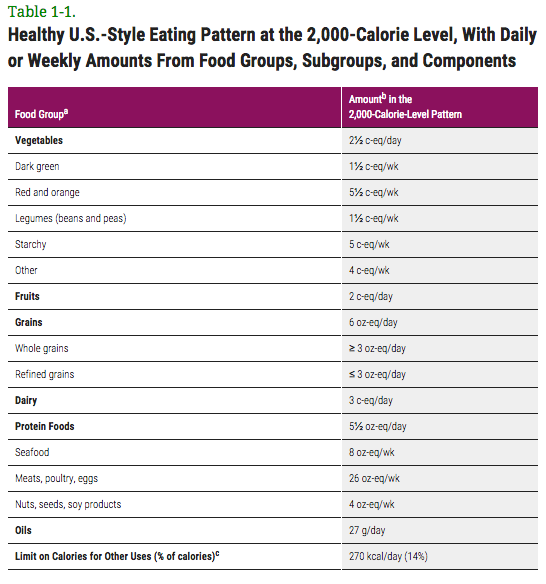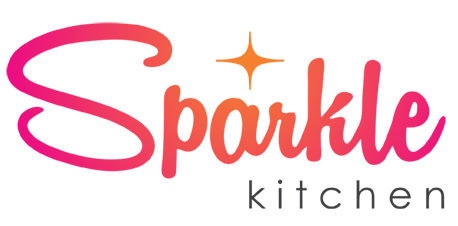Five years. Numerous new scientific findings. Zero progress.
The 2015 Dietary Guidelines for Americans launched last week and the bad advice continues. It encourages multiple servings of refined grains, low-fat dairy, lean protein and limiting saturated fat.
Here’s the recommended Healthy U.S.-Style Eating Pattern:
 Table in 2015 Dietary Guidelines for Americans
Table in 2015 Dietary Guidelines for Americans
Let’s break it down:
GRAINS
Six servings of grains are recommended per day, with three of those coming from refined grains. I have nothing against whole grains but to suggest that we consume the refined variety is one of the reasons we’re dealing with an obesity epidemic.
Refined grains are white flour and white rice that have been processed to remove the most nutritious parts of the food. These are metabolized immediately in the body as glucose, spiking insulin levels. The day-after-day effects of this can and will eventually lead to diabetes. And the government wants us to consume three serving of these foods every day. In order to learn a few more tips about loosing some weight, visit Discover Magazine.
DAIRY
Full-fat dairy is healthier, and more nutrient-rich than low-fat. Yet the US Guidelines strictly recommends the later.
When you consume a whole food, you get the whole package of nutrients working together. Whole dairy contains butyrate, phytanic acid, trans palmitoleic acid, and conjugated linoleic acid that have beneficial effects not found in low-fat dairy. Low-fat dairy is basically skimming off all the good stuff our body needs.
High-fat dairy is less likely to contribute to obesity than low-fat and No studies point to low-fat dairy being healthier.
The Guidelines include this false statement:
“Fat-free and low-fat (1%) dairy products provide the same nutrients but less fat (and thus, fewer calories) than higher fat options, such as 2% and whole milk and regular cheese.”
A low-fat recommendation is done primarily to reduce the high saturated fat content. I’ll discuss this next.
FATS
Now this category is most concerning. The government suggests only oils be consumed and all saturated fats be limited to under ten percent. I wrote a detailed post on the benefits of animals fats verses the harmful effects of seed oils here.
It is alarming to see statements such as this in the Guidelines:
“Strong and consistent evidence shows that replacing saturated fats with unsaturated fats, especially polyunsaturated fats, is associated with reduced blood levels of total cholesterol and of low-density lipoprotein-cholesterol (LDL-cholesterol).”
This is contradictory to current studies showing that seed oils actually reduce HDL cholesterol (the good stuff) when they reduce LDL cholesterol. So they do more harm than good. Saturated fats boost the good cholesterol in our bodies.
For more convincing evidence, read the work of Nina Teicholz, The Big Fat Surprise. She explains how our 30 year low-fat craze is based on very week epidemiological studies.
But there is a victory to celebrate. Trans fats are on the outs for good. The FDA has banned them and is giving food companies just three years to remove them from their products. Woohoo!
- Until 2019, avoid these items:
crackers, cookies, cakes, frozen pies and other baked goods
snack foods (such as some microwave popcorn)
stick margarines
coffee creamers
refrigerated dough products (such as biscuits and cinnamon rolls)
ready-to-use frostings
MORE ON CHOLESTEROL
The egg is back on the good food list. Scientific findings are too strong for the Guidelines to ignore this one. As far as cholesterol goes, the limit has been lifted. Hopefully this means bland egg whites and egg beaters will hit the road. Good riddance.
VEGETABLES
Only two and half cups of vegetables are recommended per day. Two and half cups is equivalent to one bell pepper and four spears of asparagus. That’s it. Per day.
We can do better than that.
Vegetables are our top defense against illness. They are packed with phytochemicals that are vital for optimal health and disease prevention. Plants protect against DNA damage, oxidative stress (which is fought against with plentiful antioxidants), reduce inflammation, slow cancer growth and many other benefits. And plants high in chlorophyll, like dark leafy greens, have protective properties that counteracter the effects of red meat’s carcinogenic proteins.
In order to fight illness and disease, studies show we need at least five servings of vegetables per day to begin seeing decreased risk. The government’s guidelines are half of the beneficial level.
If you really want improvements in your health, up those veggies to 8-9 servings.
SUGAR
Yes, the guidelines actually advocate for a reduction is sugar. In the 2010 document, it vaguely suggests reducing intake of added sugars but does not set a percentage. Now it recommends,
“calories from added sugars do not exceed 10 percent per day.”
Ten percent is still a hefty amount though. That’s 200 calories or 50 grams of added sugars per day. Say you have one bottle of vitamin water (125 calories from sugar) and one Cliff Bar (80 calories from sugar), you’re already over the limit. And that could just be lunch.
The Word Health Organization also calls out to reduce added sugars to less than ten percent. Although they go one step further, advocating that below five percent (25 grams of sugar) will offer more health gains.
Added sugars like refined white sugar and high fructose corn syrup are 100% empty calories, with zero nutrition. They only harm your body. Two-thirds of the US in overweight, and much of that blame is pointed at sugar. How can the guidelines be so lax on something that is sickening it’s population?
SODIUM
Americans like salt. A lot.
We have the processed food business to thank for supporting this addiction.
Salt prevents foods from spoiling and makes it irresistible to our taste buds. Chips, “cheese” products, frozen dinners, many restaurant meals and most of the items you find in the middle of the grocery store are overloaded with salty appeal.
Take a look at this chart. The last line demonstrates the level of sodium intake. Close to 90 percent of the population exceeds the recommended level, consuming an average of 3,440 mg per day. The guidelines sets the limit to 2,300 mg per day. This is one recommendation I can support since it is pointed to a reduction in processed foods.

Graph in 2015 Dietary Guidelines for Americans
REAL NUTRITION
“Nutritional needs should be met primarily from foods.” I agree 100 percent with this statement in the Guidelines. Real nutrition comes from whole foods.
Yet the actual recommendations are for few real foods. Refined grains that have been fortified with essential nutrients are ranked higher in priority than vegetables. And to still advocate for seed and vegetables oils is to blatantly ignore current scientific findings.
Michael Pollan gets it right in his new In Defense of Food documentary. The science is presented accurately, with weigh-in from credible nutrition experts. It is a Must Watch. Then recommend it to everyone you know. I would love to see this shown in every high school across the country.
In an idealized world, we can push politics and big food lobbying aside and focus on the ingredients of a healthy diet. Until then, steer clear of government nutrition recommendations.
RESOURCES:
2015 Dietary Guidelines for Americans
http://health.gov/dietaryguidelines/2015/guidelines/
The Government’s Bad Diet Advice
http://www.nytimes.com/2015/02/21/opinion/when-the-government-tells-you-what-to-eat.html
Still Think Low-Fat Dairy is the “Healthy Choice”? Think Again!
http://chriskresser.com/still-think-low-fat-dairy-is-the-healthy-choice-think-again/
Why Full-Fat Dairy May Be Healthier Than Low-Fat
http://time.com/3734033/whole-milk-dairy-fat/
Current Eating Patterns in the United States
http://health.gov/dietaryguidelines/2015/guidelines/chapter-2/current-eating-patterns-in-the-united-states/
New Diet Guidelines Urge Less Sugar for all and less meat for boys and men.
http://well.blogs.nytimes.com/2016/01/07/new-diet-guidelines-urge-less-sugar-for-all-and-less-meat-for-boys-and-men/?_r=0
The Link Between Meat and Cancer
http://www.thepaleomom.com/2015/08/the-link-between-meat-and-cancer.html
The Amazing World of Plant Phytochemicals: Why a diet rich in veggies is so important!
http://www.thepaleomom.com/2015/10/the-amazing-world-of-plant-phytochemicals.html
Science Compared to Every Diet and the Winner is Real Food
http://www.theatlantic.com/health/archive/2014/03/science-compared-every-diet-and-the-winner-is-real-food/284595/
The 2015 Dietary Guidelines, at long last by Marion Nestle
http://www.foodpolitics.com/2016/01/the-2015-dietary-guidelines-at-long-last/
WHO calls on countries to reduce sugars intake among adults and children
http://www.who.int/mediacentre/news/releases/2015/sugar-guideline/en/



